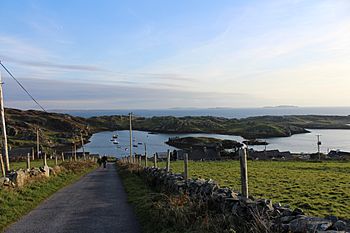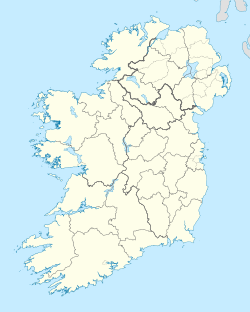Inishbofin, County Galway facts for kids
|
Native name:
Inis Bó Finne
|
|
|---|---|

Road above Inishbofin harbour
|
|
| Geography | |
| Location | Atlantic Ocean |
| Coordinates | 53°37′N 10°12′W / 53.617°N 10.200°W |
| Area | 12 km2 (4.6 sq mi) |
| Length | 5.5 km (3.42 mi) |
| Width | 3 km (1.9 mi) |
| Highest elevation | 70 m (230 ft) |
| Highest point | Westquarter |
| Administration | |
| Province | Connacht |
| County | Galway |
| Demographics | |
| Population | 160 (2011) |
Inishbofin is a small island located off the coast of Connemara, in County Galway, Ireland. Its name comes from the Irish words Inis Bó Finne, which means 'Island of the White Cow'.
About 180 people live on Inishbofin. It is a popular place for tourists to visit.
Contents
What's in a Name?
The name Inishbofin comes from the Irish phrase Inis Bó Finne. This means 'Island of the White Cow'. There are many old stories about how the island got its name.
One popular legend says the island used to float around. Fishermen landed on it during a foggy day. They brought fire onto the island, which broke the magic spell. This made the island stay in one place. Then, they saw an old woman with a white cow. When she hit the cow with a stick, it turned into a rock!
Sometimes, the island's name is also spelled 'Innisboffin' or 'Boffin' island.
Island Shape and Nature
Inishbofin is about 8 kilometers (5 miles) from the Connemara coast. It is near Ballinakill Harbour and Cleggan Bay. A small channel separates it from another island called Inishark.
The island is about 5.5 kilometers (3.4 miles) long and 3 kilometers (1.9 miles) wide. The highest point on the island is in Westquarter. It rises to about 70 meters (230 feet).
Much of Inishbofin is a Special Area of Conservation. This means it's a protected area for nature. Rare birds like the corn crake and seals live here. The island has no trees or forests. People cut down all the wood for heating long ago. The salty air has stopped new trees from growing back.
A Look Back in Time: Inishbofin's History
We don't know exactly when people first lived on Inishbofin. There isn't much proof of people living here in the very early Stone Age. Some old field systems exist, but we are not sure how old they are. They could be from the Bronze Age or even the early Middle Ages.
The first clear signs of people are from the Iron Age. These include the remains of old forts called 'Dun Mor'.
Monastery and Pirates
Around the year 665, a holy man named Saint Colmán started a monastery on Inishbofin. The island was ruled by Guairim of Inisbofin at that time. Records show the leaders of the monastery until the early 900s.
The O'Flaherty family owned the island until 1380. Then, the O'Malleys took control of it. In the 1500s, local stories say a Spanish pirate named Alonzo Bosco built a fort on Port Island. This is where Cromwell's fort stands today. Bosco was said to raid the Irish coast. He was also an ally of Gráinne O'Malley, who was known as 'Ireland's pirate queen'.
One story says they stretched a strong iron chain across Inishbofin's harbour entrance. This was to stop enemy ships from entering. Across the harbour from Port Island is 'Dún Gráinne'. This fort is where Gráinne O'Malley supposedly lived.
Wars and Changes
Later, forces loyal to Queen Elizabeth I took the island. By 1609, Inishbofin belonged to the Earl of Clanricard.
During the wars after the Irish rebellion of 1641, Inishbofin was important. It was a place where weapons were brought for Irish rebels and their allies. In 1649, forces led by Oliver Cromwell began to conquer Ireland. Inishbofin was one of the last places to surrender to Cromwell's army in 1653.
After taking the island, Cromwell's forces used Inishbofin as a prison. They held Catholic priests who were arrested in other parts of Ireland here. The large fort that guards the harbour was built around this time. It is known as "Cromwell's Barracks" today. Besides being a prison, it protected the harbour from pirates and Dutch ships. At that time, many people on the island were involved in fishing and whaling.
In 1690, the fort was held by soldiers loyal to King James II of England. They surrendered to King William's forces in 1691.
Shipwreck and Land Ownership
In 1779, a British ship was caught in a storm during the American Revolutionary War. It crashed at Inishbofin, in a place called Royal Oak Cove. Many soldiers died. Some of the survivors ran away and were later caught.
Around 1830, the Browne family of Westport took ownership of Inishbofin. They were related to the O'Malleys. Later, the island was sold to Henry William Wilberforce. Eventually, a group called the Land Commission bought the island. This group helped people get land.
In 1873, Inishbofin officially became part of County Galway. Before that, it was part of County Mayo. This change happened because of a severe food shortage. It was easier to get help from the nearest relief center in Clifden, which was in County Galway.
Island Population
The number of people living on Inishbofin has changed a lot over time. The population was much higher before the Great Famine in the 1840s. In 1837, there were 1,462 people. By 2011, the number was 160.
| Historical population | ||||||||||||||||||||||||||||||||||||||||||||||||||||||||||||||||||||||||||||||||||||||
|---|---|---|---|---|---|---|---|---|---|---|---|---|---|---|---|---|---|---|---|---|---|---|---|---|---|---|---|---|---|---|---|---|---|---|---|---|---|---|---|---|---|---|---|---|---|---|---|---|---|---|---|---|---|---|---|---|---|---|---|---|---|---|---|---|---|---|---|---|---|---|---|---|---|---|---|---|---|---|---|---|---|---|---|---|---|---|
|
|
|
||||||||||||||||||||||||||||||||||||||||||||||||||||||||||||||||||||||||||||||||||||
| Source: | ||||||||||||||||||||||||||||||||||||||||||||||||||||||||||||||||||||||||||||||||||||||
Today, tourism is the main way people make a living on the island. Inishbofin has three hotels and a hostel. Visitors can enjoy many activities. These include scuba diving, walking, cycling, and horse riding. You can also go sailing, paddle boarding, kayaking, or snorkeling. Fishing from the shore or a boat is also popular.
Getting There
You can reach Inishbofin by ferry from Cleggan pier. The island also has a helipad and an airstrip. However, these airfields are not currently licensed for use. This means planes are not allowed to land there.
Fun and Games
The island has a football pitch for sports. There is also a community center with an indoor sports hall. Inishbofin has a small library too. It has books and information about the island's history.
Inishbofin has hosted the All-Ireland Islands Football Tournament twice. This happened in 2008 and again in 2017. Some talented football players come from the island. Ruairi Lavelle, a goalkeeper for the Galway Senior Men's Football team, is from Inishbofin. Michael Day, another islander, also played for the Senior team in 2017.
Places to See
- Cromwell's Barracks (an old fort)
- St. Colmán's Cemetery (ruins of a 13th-century church)
- Light on Gun Rock (a lighthouse built in 1909)
- Dún Mór (an ancient fort on a headland)
- Dún Gráinne (another old fort)
- The Stags seal colony (where seals live)
Inishbofin in Books and Poems
The Irish artist and writer Robert Gibbings wrote about Inishbofin in 1946. He mentioned some old village names that no longer exist. This suggests those villages have disappeared.
The famous poet Seamus Heaney wrote a poem called "Seeing Things." It starts with a boat trip to Inishbofin. The island was also the setting for Deborah Tall's 1987 book, The Island of the White Cow. Richard Murphy wrote several poems about his time on Inishbofin, including 'Sailing to an Island'.
Important Dates from History Records
- 668 - Colmán of Lindisfarne starts the monastery of Inis Bó Finne.
- 675 - Colmán of Lindisfarne passes away on Inis Bó Finne.
- 711 - Baetan, a Bishop from Inis Bo Finne, dies.
- 755 - Mael Turaig, the abbot (leader) of Inis Bó Finne, rests.
- 795 - The islands of Í Coluim Chille, Inis Muiredaig, and Inis Bó Finne are raided.
- 898 - Caenchomhrac, known for the caves of Inis Bo Fine, dies.
- 809 - Blathmac of Inis Bó Finne dies.
- 916 - Abbot Feardhach of Inis Bó Finne dies.
Images for kids






